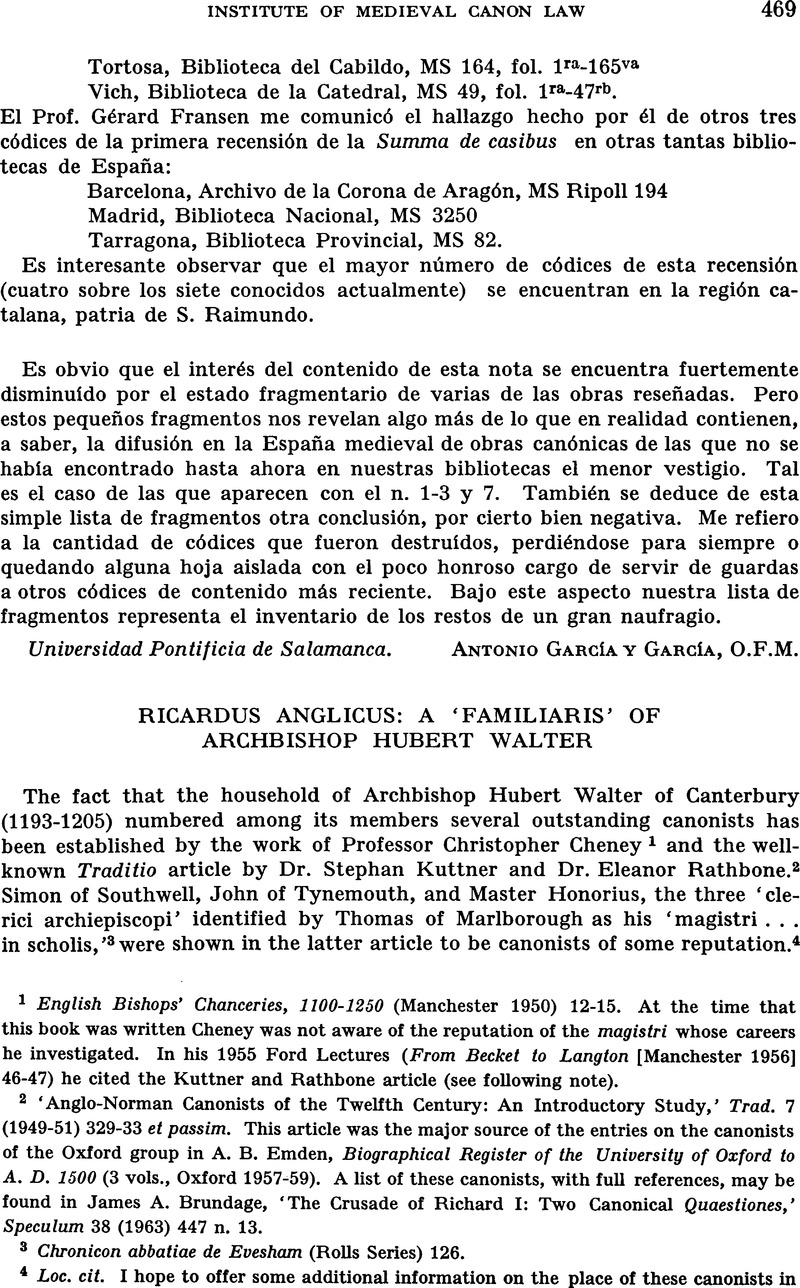Published online by Cambridge University Press: 29 July 2016

1 English Bishops’ Chanceries, 1100–1250 (Manchester 1950) 12–15. At the time that this book was written Cheney was not aware of the reputation of the magistri whose careers he investigated. In his 1955 Ford Lectures (From Becket to Langton [Manchester 1956] 46–47) he cited the Kuttner and Rathbone article (see following note).Google Scholar
2 ‘ Anglo-Norman Canonists of the Twelfth Century: An Introductory Study,’ Trad. 7 (1949–51) 329–33 et passim. This article was the major source of the entries on the canonists of the Oxford group in Emden, A. B. Biographical Register of the University of Oxford to A. D. 1500 (3 vols., Oxford 1957–59). A list of these canonists, with full references, may be found in Brundage, James A., ‘The Crusade of Richard I: Two Canonical Quaestiones,’ Speculum 38 (1963) 447 n. 13.Google Scholar
3 Chronicon abbatiae de Evesham (Rolls Series) 126.Google Scholar
4 Loc. cit. I hope to offer some additional information on the place of these canonists in Hubert's familia in an article on the archbishop's household, a preliminary version of which was read to the University of Kentucky Foreign Language Conference, Medieval Studies Section, April 1966.Google Scholar
5 Kathleen Major, ed., Acta Stephani Langton (Canterbury and York Society; 1950) No. 37 p. 50. This actum was cited by Kuttner and Rathbone, ‘Anglo-Norman Canonists’ 338 n. 76. Google Scholar
6 Dictionary of Writers of Thirteenth Century England (London 1933) 111–13.Google Scholar
7 ‘ Anglo-Norman Canonists ’ 329–38. The most recent biography of Master Richard is Kuttner, S., ‘Ricardus Anglicus (Richard de Mores ou de Morins),’ DDC 7 (fasc. 39; 1960) 676–81. Manuscripts of Richard's canonistic writings are listed in Kuttner, Repertorium 222ff., 417ff.; ‘Bernardus Compostellanus Antiquus,’ Traditio 1 (1943) 299, 312, 321 n. 4, 323–24 notes; in the Interim Checklists of MSS, in this Bulletin, Trad. 11 (1955) 444–5, 448; 12 (1956) 564; 13 (1957) 469–70; 15 (1959) 499; and in DDC 7.678–81. Excerpts are printed in ‘Anglo-Norman Canonists’ App. E.Google Scholar
8 Supra n. 5. I have written out ‘et’ where the editor used a siglum.Google Scholar
9 For Simon of Southwell, Adam of Walsingham, and Robert of Bristol, see Cheney, , Chanceries 13 and 15, respectively. Edmund of Hampton witnessed another charter inspected by Langton: Acta Stephani Langton 47 (from Monasticon Anglicanum 6. 565). He may be the ‘Master Edmund’ who witnessed Magnum Registrum Album (Lichfield) (William Salt Archaeological Society; 1924) 358.Google Scholar
10 Annales Monastici (Rolls Series) III 31, 66, ad ann. 1208, 1221. The coincidence was pointed out in ‘Anglo-Norman Canonists’ 309, 325, in a slightly different connection.Google Scholar
11 Ibid. 338.Google Scholar
12 Ann. Monast. III 28.Google Scholar
13 Simon was still a canon of Lincoln in 1202: The Earliest Lincolnshire Assize Rolls (ed. Stenton, D. M. Lincoln Record Society; 1926) VIII no. 51, cited in ‘Anglo-Norman Canonists’ 326. The evidence of the witness list quoted above indicates that he became treasurer in 1202 some time before Richard de Mores was installed as prior of Dunstable. This conclusion does not conflict with the references cited by Kuttner and Rathbone, ibid. 326 n. 47, who stated that Simon probably gained his treasurership in 1203.Google Scholar
14 See preceding note. Richard was a canon of the Austin house of Merton (Ann. Monast. III 28). Google Scholar
15 Dr. Kuttner, in a letter, informs me that in the Quaestiones Londinenses (post 1196) Master Nicholas de Aquila (de l'Aigle) quoted an opinion ‘secundum magistr. ricc.’ (This passage was not given in the articles of Kuttner and Rathbone or Brundage, supra n. 2). Dr. Kuttner's discovery opens the possibility that Ricardus Anglicus left Bologna for Oxford, where he was a member of the circle of John of Tynemouth c. 1196–98. Google Scholar
16 ‘ Anglo-Norman Canonists ’ 324–25. John was definitely a member of the archiepiscopal household in 1199, when he participated in the settlement of the famous case between the abbey of Bec and the canons of Wells concerning the parish of Cleeve. The relevant documents are cited by Cazel, F. A., ‘Norman and Wessex Charters of the Roumare Family,’ Medieval Miscellany for Doris Mary Stenton (Pipe Roll Society, 1960) 83–84, 88.Google Scholar